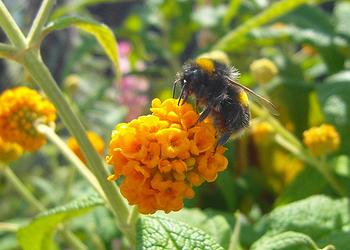
BRIGHTON, UK, January 29, 2014 (ENS) – Controversial pesticides ingested by bumble bees can seriously impact the insects’ ability to collect food, even at very low levels of contamination, finds new research from the University of Sussex and the University of Stirling.
The study shows that even tiny doses of a neonicotinoid pesticide called imidacloprid reduce the amount of pollen collected by bumblebee colonies by 57 percent, and that the effects last for at least a month after exposure.

Neonicotinoids are the most widely used insecticides in the world, with about 80 tonnes applied to 1.3 million hectares in the UK alone. They are mostly applied as a seed dressing, and being systemic they are absorbed by the growing crop and spread through its tissues.
The researchers fitted bees with electronic tags so that their movements could be tracked. Each bee was weighed as it exited and entered its nest. Many pesticide-treated bees failed to collect any pollen at all, and those that did tended to collect less than untreated bees.
Imidacloprid is one of three neonicotinoids currently the subject of a two-year EU moratorium due to honey bee health concerns.
Neonicotinoids have previously been linked to Colony Collapse Disorder in honey bees, and more generally they have been implicated in causing pollinator declines.
Neonicotinoids are synthetic variants of nicotine and used to kill insect pests. Applied as a seed dressing, the pesticide gets into the pollen and nectar of crops such as oilseed rape, which the bees feed on.
Neonicotinoids are neurotoxins that exhibit extremely high toxicity to beneficial insects; for example the LD50 (dose that kills 50 percent of test subjects) for the most commonly used neonicotinoid, clothianidin, is four billionths of a gram in honeybees. Hence one gram delivers an LD50 to 250 million bees.
Lower doses cause disorientation and navigational errors, the researchers found.
The bees in this study were fed the neurotoxin imidacloprid at a rate of 0.7 parts per billion in nectar and 6 parts per billion in pollen, mimicking levels that are found in treated oilseed rape.
Debate has raged as to whether bees consume enough to do them harm, and these concerns led to the EU moratorium.
Professor Dave Goulson, the study’s senior author, says, “It is unclear what will happen when the moratorium expires, as the agrochemical companies that produce them are in a legal dispute with the EU over their decision. Our new study adds to the weight of evidence for making the ban permanent.”
Previous work by Professor Goulson and others suggests that bumblebees are particularly sensitive to the chemical agents in neonicotinoids; that their nests grow more slowly when they have been exposed to them, and that they produce fewer new queens. The new study suggests why these negative impacts might be occurring.
Goulson adds, “Pollen is the only source of protein that bees have, and it is vital for rearing their young. Collecting it is fiddly, slow work for the bees and intoxicated bees become much worse at it. Without much pollen, nests will inevitably struggle.”
Hannah Feltham, from the University of Stirling, who carried out the experiments, says: “This work adds another piece to the jigsaw. Even near-infinitesimal doses of these neurotoxins seem to be enough to mess up the ability of bees to gather food. Given the vital importance of bumblebees as pollinators, this is surely a cause for concern.”
Friends of the Earth’s Nature Campaigner Sandra Bell, said, “This new research provides further evidence that pesticides are harming bees and underlines why the temporary ban on the insecticide imidacloprid was so urgently needed.”
The study, “Field realistic doses of pesticide imidacloprid reduce bumblebee pollen foraging efficiency,” is published online in the current issue of the journal “Ecotoxicology.”
